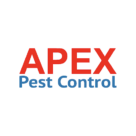Apex Pigeon Control Help in Yorkshire, UK.
We Protect Your Property from Bird Invasion.
- Professional Pest Control, our Services offer Inspection, Treatment and Prevention for:
- Expert pigeon removal service
- Remove problem birds quickly
- Future proof your building against pigeons
- We remove all bird droppings and sterilise the area.
- Solar panels bird proofing
- Air Conditioning Units protected


We'll Take Care of Your Bird Problem and Clean up the Mess.
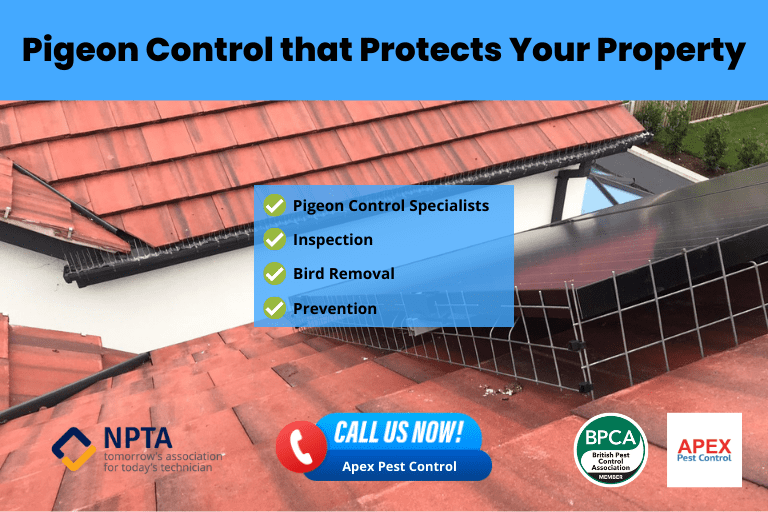
Protect your family or business against potential health issues. Diseases from pigeons include Ornithosis, Listeria and E-coli.
Any area that contains bird droppings potentially carries a health risk and is contaminated.
The first part is to remove the bird problem, and the second part is to proof the property and clear the hazardous pigeon droppings and make the location safe.
How much does pigeon control cost?

Pigeons can cause property damage that can cost you hundreds, if not thousands of pounds to fix. The expense of having birds removed from your property might range between £70 and £250 on some domestic properties.
However, bird-proofing your property will cost a lot more, depending on:
The pigeons roosting flock size
Size of property to protect
Any health and safety concerns
Size of bird population to remove and area to sterilise.
Bird Deterrent Solutions Successful Pest Management
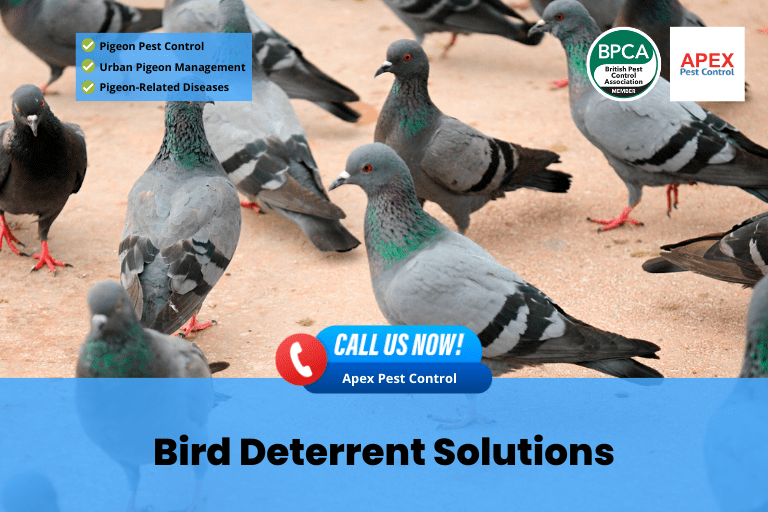
Urban Pigeon Management At Apex Pest Control our best Practises are:
Sanitation
Removal of food sources
Pigeon proofing buildings
At some premises, there is a need for ongoing pest management to remove the birds. Such examples may be that a nearby venue or problem outside your control is a food source for the birds.
In these scenarios pigeon-proofing, the building is a must to act like a pigeon deterrent to keep the birds away.
Pigeons. The ever-present dwellers of UK’s city centres and urban spaces. Charming to some, a nuisance to others – especially when they decide your property is their new home.
From droppings decorating your facades to the noise of coos, pigeons can be rather unwelcome guests.
Pigeon droppings, or guano, are not just unsightly.
They can serve as breeding grounds for diseases like Salmonella. Pigeon droppings, bird droppings, in general, can be a bit of a headache. For business owners, a bird problem can be detrimental to the reputation of your establishment, especially in bustling shopping centres.
Best Pest Control for Pigeons, How we Solve Your Bird Problem

Bird Proofing – there are lots of different types of bird proofing and pigeon deterrents to suit all situations, depending on how we grade the problem from low pressure to heavy pressure systems our options are from:
- Low-pressure post and spring wire systems
- Stainless steel spikes
- Electrical bird deterrent systems.
- Bird Netting
- Trapping
- Shooting
Bird proofing
Bird proofing in large areas by fixing bird netting to the roof tiles front of the building, which is tensioned. The mesh may come in different colours to suit the building materials. Zips may be placed in the netting if required to allow access for maintenance.
Shooting
The first method of control is by use of barrier systems such as netting or spikes. However, shooting requires an individual licence for pest controllers.
To shoot pest birds is mainly inside factories or buildings where pigeons are roosting and nesting, for example on ledges, girders or windowsills.
Any shooting takes place after dark when the pigeons are roosting and reluctant to fly out of the building. Every shot must meet an ethical code of conduct and limit suffering.
After an area gets cleared, access into the building needs to be proofed to stop further bird infestation there.
Trapping
The trapping of pigeons generally takes place on top of buildings or in areas pigeons feed regularly. The food source areas will require all food sources eliminated.
The cage traps are then placed down and baited for several days with the doors left open.
Once the birds get used to going into the traps to feed the doors are set so that the pigeon can enter the traps but not access back through the opening.
Water, as well as food, needs to be placed in the trap. Regular visits to the traps need to be carried out every 12-24 hours to remove trapped pigeons.
Trapping may carry on for several days then a period left with the traps not set before re-trapping begins. On problem sites, a 12-month contract may be required to maintain control of pest pigeons.
Non-target birds caught in the traps can be released unharmed. Large amounts of pigeons may be trapped using this method.
Why use Apex for the Best Pigeon Pest Control?
- Professional pest technicians
- NPTA Certified
- BPCA Members
- Fast and discreet treatment
- Insured
Why Pigeon Control is Vital
Keeping pigeons at bay isn’t just for Instagram aesthetics. From damage to health risks, a pigeon control system is quintessential for any UK property. Regular cleaning and installation of bird deterrents is crucial for feral pigeon prevention
Get a Grip on Your Bin Lids!
Secure your bin lids and ensure there’s no food source to invite these pesky birds. Birds like the common pigeon might even take the liberty to feed on anything available. They aren’t fussy eaters, you see.
Typically, a feral pigeons diet is seeds, fruits, plants, food scraps, and occasionally small insects.
The Health Hazards Lurking in the Wings
Pigeons are notorious carriers of diseases like avian influenza and salmonellosis. Better safe than sorry! Mind you, some bird mites might also hitch a ride on pigeons. These mites might bite humans and become an additional nuisance.
The Perils of Pigeon Guano
Pigeon droppings are acid-laden – quite the superpower if they were superheroes, but unfortunately, they’re not. Moreover, their droppings can contribute to the breeding of insect infestations. Yikes!
Physical Deterrents to Stop Perch and Roost
Bird spikes might not be setting any fashion trends, but they’re top-notch in keeping pigeons at arm’s length.
Bird control spikes, or pigeon spikes, are rather handy. Make sure you get the spike installations done properly.
Steel or Plastic – Your Call! Steel spikes: The British Bulldog of pigeon control. Plastic spikes: Easier on the wallet and not half bad, either. But, remember, pigeons are part of a range of bird species. So, if you are trying to get rid of pigeons, keep an eye out for other birds as well.
It’s a Net Gain with Bird Netting
Netting is like that polite bouncer who ensures the pigeons don’t gatecrash the party at your property. Besides, it is a strongly recommended bird-proofing method.
Netting Essentials Polyethylene or Polypropylene – both are champions in their own right. UV-stabilised netting is the way to go – you don’t want the Great British weather to wear it down. Also, UV-stabilised netting generally has a longer lifespan.
Bird Slopes: Give Pigeons the Slip! Think of the slopes as a greased-up cricket pitch. Pigeons just can’t get their footing! This method of bird control can be extremely dangerous but is quite efficient in preventing birds from finding comfy spots.
Using Sound Deterrents
Ultrasonic Devices: The Unseen Protectors
Ultrasonic devices are the James Bonds of pigeon control. Silent to us, but a right racket in the pigeon’s ear. A bird-repellent gel is another nifty little trick in your arsenal. But remember, old sport, check the local wildlife regulations before getting these.
Using Visual Deterrents
The Decoy Trick for roosting pigeons.
Decoys of predatory birds like falcons can be quite the scarecrow for pigeons. Hawking kites and birds of prey can also be employed as a bird of prey pest control method.
Shiny Shenanigans Reflective surfaces are pigeon enemy number one. Whether it’s shiny tape or old CDs, pigeons can’t stand the dazzle. Another point in your favour is if you want to give these airborne invaders a taste of their own medicine.
The Legal Acts for Pest Birds
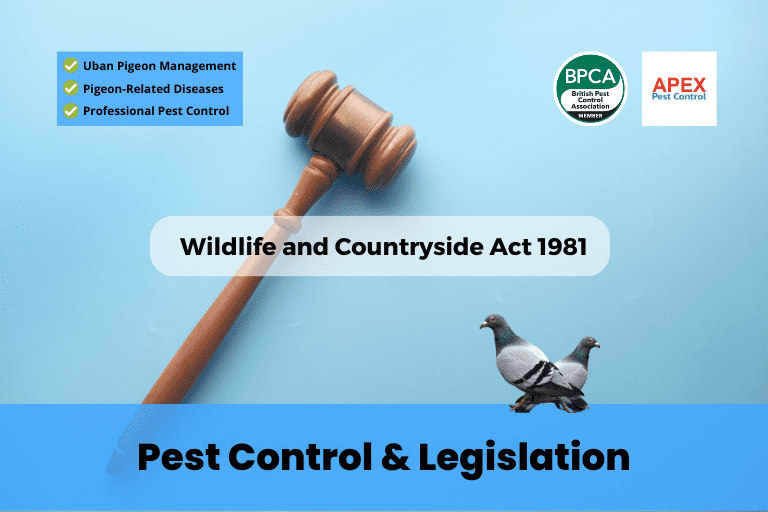
It’s crucial to remember the Wildlife and Countryside Act 1981. Pigeons are part of British wildlife, so be sure to check out the dos and don’ts of pigeon control.
Ensure that health and safety are taken into consideration as well. Using personal protective equipment is a wise choice while handling bird droppings.
Know When It’s Time for Professional Help
Getting the Pros on Your Team
When the pigeons are waging a full-blown assault, it’s time to call in the professionals. These bird control specialists are more than qualified and are well-versed in bird control. We’re talking about professional pest controllers, members of the British Pest Control Association.
Consultation: Tailoring a Defence Plan
Expert pigeon control services by Apex Pest Control will give you a bespoke plan that’s the dog’s bollocks. A plan that takes into account the types of birds, their breeding season, and the various pigeon control products and methods.
Expert Services Include: Installation of deterrents Chemical treatments Pigeon removal Regular maintenance You might even get advice on bird-repellent gels and shock tracks. In case you find a nest on your property, nest removal is something we can assist with.
Pigeon Control Services and Bespoke Plans to Stop Pesky Pigeons in the UK
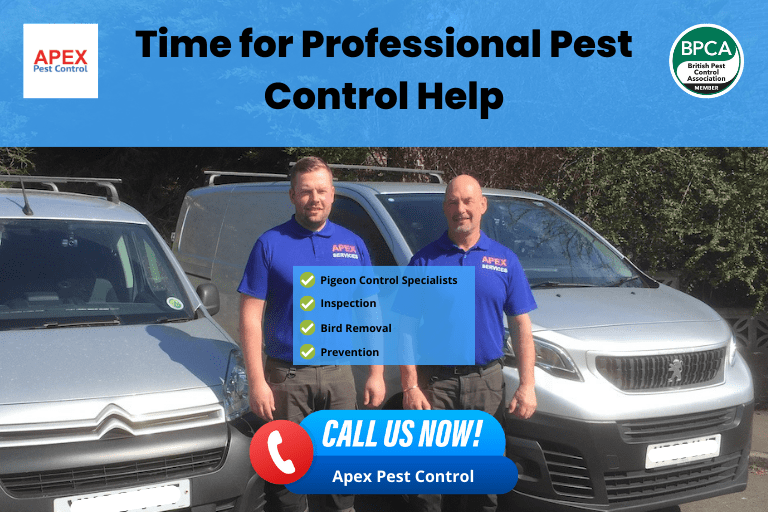
Well, there you have it, the A to Z of pigeon control in the UK. With an armoury of knowledge, it’s time to reclaim your property from our feathered foes.
Keep it humane, keep it legal, and you’ll have a pigeon-free space. Also, let’s not forget the sheer diversity in bird control and proofing methods.
Solar panel bird proofing is gaining traction, and the use of seagull spikes is quite prevalent. Here’s to pigeon free days!
If you want to unlock the easy method to eradicate pigeons from your property successfully, we offer a quality and reliable bird control service. To arrange a bird management and talk to a specialist about your bird problem act fast and contact us today.
You can read more helpful tips here on How to get rid of pigeons on the roof.
Frequently Asked Questions
Pigeon guano or pigeon waste, can carry bacteria and fungi that cause diseases.
Yes, the pigeon’s droppings produce a source of harmful diseases and pathogens which humans may come into contact with and produce disastrous results. Here is a list of hazards from pigeon and bird droppings:
- Salmonella
- Listeria
- Protozoa
- Rikkettsiales
- Ecoli
- Ornithosis
- Psittacosis
- Histoplasmosis
These can be inhaled through dust or by coming into contact with droppings themselves. You should leave the cleaning of the faeces to an environmental cleaning company or take the necessary steps in personal protection from contact with the droppings and discard the waste in line with the latest disposal of waste regulations.
Historically, these birds descended from rock doves, which explain why they often nest on buildings and other structures, usually on ledges, under eaves or on girders.
Nests are constructed of grass and twigs but can also contain rubbish such as pieces of plastic.
The feral pigeon breeding population will get boosted by racing pigeons or escaped birds from domestic pigeon lofts.
The breeding season is between March and July, but feral pigeons are capable of breeding all year round.
To keep pigeons away from your house or building will need no food or water source. The pigeons love to nest behind where the roof meets the chimney stack — alternatively, nest on top of the square guttering box for your fall pipe or perch on window sills.
To keep birds from being a nuisance and cause damage to your property, you will need pigeon barriers and proofing putting in place unless there is a natural predator like a hawk in your area.
Birds, bird nests and eggs are protected by law, and it’s illegal to interfere or destroy them except under licence. Even where the bird removal is licensed, non-lethal methods get considered first, and lots of the killing methods are outlawed. To use Lethal means professional pest controllers that are under exclusive licence should be employed.
From bird spikes and netting to ultrasonic devices, there’s a wide range of humane deterrents.
It’s imperative to abide by the Wildlife and Countryside Act 1981, which protects certain bird species, including pigeons. Always ensure that the methods used are legal and humane.
Yes, there are emergency services available to handle bird infestations, especially when it pose a significant health risk.
One effective bird control method for deterring feral pigeons is using bird spikes on fences and other perching areas. These spikes prevent pigeons from landing and discourage them from returning to the area. I’ve got pigeons nesting under my solar panels.
Read more on Bird Control here.
To protect solar panels from pigeons, you can install a mesh screen around the perimeter of the panels. This prevents pigeons from accessing the space beneath the panels, which they often use for nesting.
Absolutely! A professional bird controller is equipped with the knowledge and tools necessary to effectively manage pigeon populations in urban areas. They can provide tailored solutions that include bird trapping, deterrent installations, and advice on preventing future issues.
Bird repellers are devices designed to deter pigeons and other birds from perching on buildings, trees, or other structures. They can work through various mechanisms, such as ultrasonic sounds, reflective surfaces, or motion to make an area unattractive to pigeons. There are pigeons getting into my building through various entry points.
To bird-proof entry points such as vents, windows, and eaves, you can use a combination of bird netting, mesh screens, and sealant to block access to nesting pigeons. It’s also beneficial to remove any food sources that may be attracting pigeons to the area.
Bird trapping is a method used in pigeon control to capture pigeons alive. Traps are placed in areas frequented by pigeons, and once trapped, the pigeons are usually relocated. This method is considered humane if the traps are checked regularly, and the pigeons are handled with care.
To deter birds humanely, consider using visual deterrents like reflective tapes or auditory deterrents like bird repellers that emit predator calls. Another humane option is to install bird netting or use post and wire systems to prevent them from landing.
If you find dead birds on your property, it’s important to handle them with care to avoid any potential health risks. Use gloves, place the bird in a sealed bag, and dispose of it according to local regulations. It’s also advisable to clean the area where the bird was found.
Professional bird control services can offer a comprehensive approach to managing nuisance birds. This includes identifying and removing pigeons sealing entry points, installing deterrents, and providing ongoing maintenance and monitoring to ensure the pigeon problem is resolved effectively.
Pest bird control involves implementing strategies to manage bird populations that are causing issues on residential and commercial properties. This can include deterrent installations, bird trapping, and advising property owners on best practises for reducing attractions for birds.
Yes, pigeon infestations often bring along crawling pests such as mites and ticks. Pigeon nests can be breeding grounds for these pests, and they may enter your property from the nests. It’s important to address both the various pigeon problems and crawling pest issues together for effective control.
In the United Kingdom, there are legal considerations under the Wildlife and Countryside Act 1981 that protect certain bird species. It’s important to ensure that any control methods used are compliant with these laws and do not cause harm to protected bird species.
Pigeon spikes are a type of bird spike specifically designed for deterring pigeons. They are generally similar to other bird spikes but are optimised in size and spacing to be particularly effective at preventing pigeons from perching on ledges, window sills, and other surfaces.
For more details on Apex Pest Control and services they offer, please see table below.
| Related Term | Definition |
|---|---|
| Ant Control | This involves managing and eradicating ant infestations. When dealing with pigeon control, it’s crucial to consider that food sources attracting pigeons might also attract ants, necessitating ant control measures. |
| Bed Bug | A small, blood-sucking insect that infests beds and feeds on human blood. While bed bugs are not directly related to pigeons, poor pigeon control could exacerbate general pest issues, which might include bed bugs. |
| Bed Bug Treatment | The process of eliminating bed bugs from an environment using pesticides, heat treatment, or other methods. Similar to bed bug treatments, pigeon control often requires a tailored approach to address the specific issues at hand. |
| Biological Pest Control | The use of natural predators or pathogens to control pests. In pigeon control, this could involves the use of birds of prey to deter pigeons from an area. |
| British Birds | Refers to bird species that are commonly found in the United Kingdom. Pigeons are among the common British birds that sometimes require control measures due to their nuisance behaviour |
| Carpet Beetle | A small beetle whose larvae feed on natural fibres and can damage carpets. Like pigeons, carpet beetles are pests that can damage property, highlighting the need for integrated pest management strategies. |
| Cockroach Control | The management and eradication of cockroach infestations. Similar to pigeon control, Cockroach control is essential in maintaining sanitary conditions in buildings and public Spaces. |
| Dead Animal | Refers to an animal that has died, often creating sanitary concerns. In pigeon control, dead Pigeons should be removed promptly to prevent odour and secondary pest infestations. |
| Dead Animal Removal | The process of safely and sanitarily removing dead animals from a property. Like dead animal removal, effective pigeon control entails the safe removal of pigeons and their nests. |
| Fly Control | Methods used to manage or eliminate fly populations. Pigeon droppings can attract flies, hence effective pigeon control can be essential for fly control. |
| Fly Pest | Refers to flies that are considered pests due to their potential to spread diseases. Proper Pigeon control helps in reducing fly pests as pigeon droppings are a breeding ground for them. |
| Fox Control | Managing fox populations to reduce their impact on the environment or property. While different in focus, both fox and pigeon control are part of broader wildlife management Strategies. |
| Guano Clearance | The removal of accumulated bird droppings, known as guano. In pigeon control, guano clearance is essential as pigeon droppings can be hazardous to health and damage Property. |
| Insect Control | The practise of managing and eliminating insect populations that are considered pests. Good pigeon control practises can indirectly assist in insect control by removing a potential food source for some insects. |
| Mole Control | The management of mole populations to prevent damage to gardens or landscapes. Similar to pigeon control, mole control aims to mitigate the damage caused by an animal species. |
| Moth Control | Involves managing and eradicating moth infestations. Like pigeons, moths can be a Nuisance, and controlling their population is necessary to protect belongings and property. |
| Pest Inspection | A thorough assessment of a property to identify the presence of pests. During a pest Inspection, signs of pigeon activity, such as nests or droppings, may be identified. |
| Pest Management | A broad term for strategies and actions taken to control pest populations. Pigeon control is a form of pest management, focusing on mitigating the issues caused by pigeons. |
| Rabbit Control | Methods used to manage or eliminate rabbit populations. While different in species, rabbit control, like pigeon control, is important in managing wildlife populations to reduce damage and disease spread. |
| Rat Control | Involves strategies for managing and eliminating rat populations. Pigeon droppings can attract rats, making pigeon control an integral part of comprehensive rat control. |
| Rodent Control | The management of rodents, such as rats and mice. Like rodent control, pigeon control is necessary to prevent the spread of diseases and damage to property. |
| Spider Control | Methods used to manage or eliminate spider populations. While not directly related, maintaining a clean environment through pigeon control can contribute to reducing other pests, including spiders. |
| Squirrel Control | The practice of managing and reducing squirrel populations. Similar to pigeon control, squirrel control is about managing wildlife in urban areas to mitigate property damage and health risks. |
| Wasp Control | Involves managing and eliminating wasp populations. Wasp control, like pigeon control, is important for ensuring the safety and comfort of inhabitants in an area. |
| Wildlife Control | The broad management of wildlife species that may become a nuisance or pose risks to humans or property. Pigeon control is a subset of wildlife control focused on managing pigeon populations. |
| Woodworm Treatment | A treatment to eliminate wood-boring insects known as woodworms. While not directly related to pigeon control, both practices are part of maintaining the structural integrity of buildings and properties. |
Contact Us
- Apex Pest Control
- 54 Baxter Dr, Birley Carr, Sheffield, S6 1GH
- Local Branch
Members of

Follow Us
